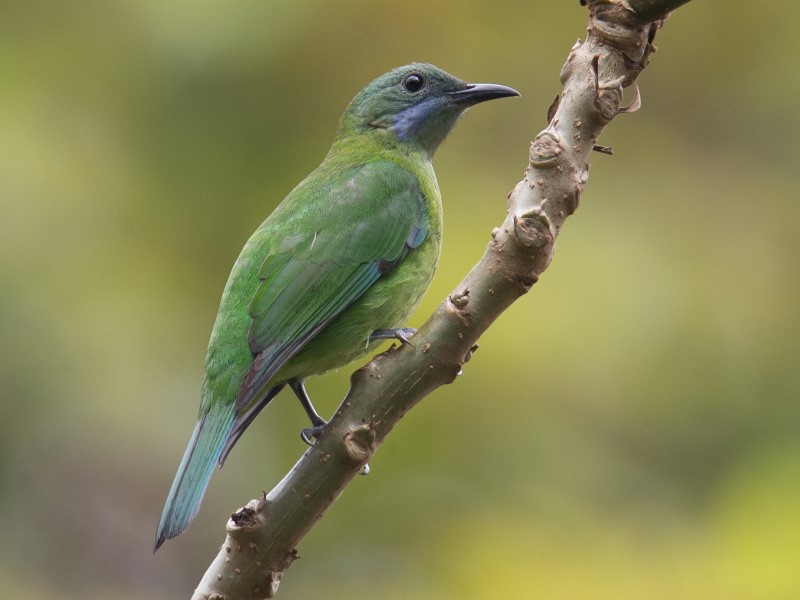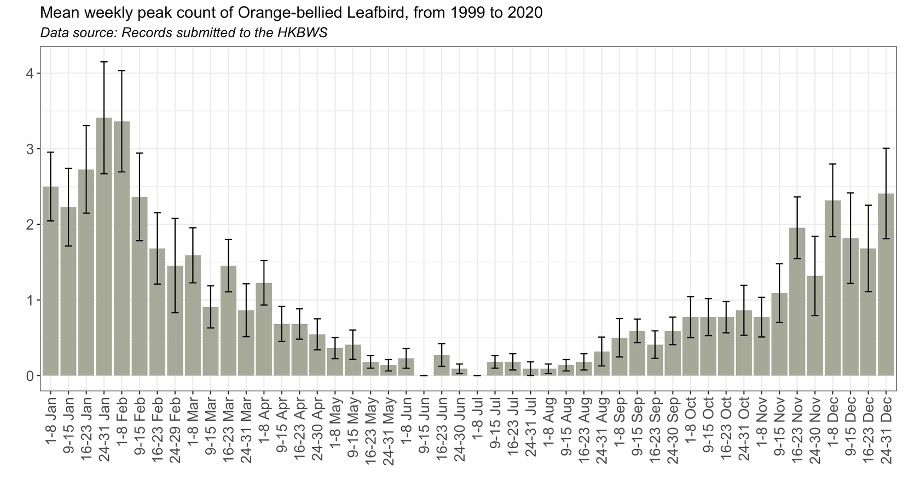Orange-bellied Leafbird Chloropsis hardwickii 橙腹葉鵯
Category I. Locally present at low-densities in forested areas largely on the mainland; a small summering population exists and it may be a regular breeding species in small numbers.
IDENTIFICATION

Jan. 2024, Matthew Kwan. Male.
17-20.5 cm. Males are bright green above, fading to yellowish on the nape and greyish on the crown. The face, throat and upper chest are black apart from a broad blue malar. The rest of the underparts are orange-yellow, while the tail is dark below and blue above. The bill is somewhat decurved and the eye dark.

Feb. 2018, James Kwok. Female.
Females are greenish overall, darker above than below, with the malar and edges to the outer tail feathers being diffuse bluish. Generally more inconspicuous and less vocal than males.
VOCALISATIONS
The extensive mimetic abilities of this species were described by Viney (1989), who noted the following species were imitated: Yellow-browed Warbler, Common Tailorbird, Swinhoe’s White-eye, Asian Tit (commixtus), Common Magpie, Red-billed Blue Magpie, Hair-crested Drongo, Great Barbet, Oriental Magpie-Robin, Chinese Blackbird, Crested Goshawk and Crested Serpent Eagle. To these can be added Ashy Drongo, Scarlet Minivet, Yellow-cheeked Tit, Chestnut and Mountain Bulbuls and Chinese Hwamei (pers. obs.). It is likely that most sounds uttered by this species are mimetic to some degree. It is not possible to provide here a full range of such an accomplished vocalist; instead, a selection of the more typical vocalisations is provided.
The song tends to be a series of similar mid frequency phrases, distinctive for their timbre rather than structure or pattern of modulation. There is substantial variation among birds.
What is presumed to be courtship song is given in November and December. This is a quiet medley of buzzes, trills and chattering sounds that, broadly speaking, are more similar in character than the diverse range of calls and territorial song.
As for two examples of mimicry, the first illustrates the use as an alarm call the equivalent call of Oriental Magpie-Robin.
The second provides mimicry of a typical call of Chestnut Bulbul.
DISTRIBUTION & HABITAT PREFERENCE
There was no change in the percentage of occupied 1 km squares between the breeding bird surveys of 1993-96 and 2016-19, in both of which it was 0.4%. The breeding season distribution in the 1993-96 survey was confined to the Tai Mo Shan massif apart from an anomalous record in the Chi Ma Wan peninsula, Lantau. During the 2016-19 survey it was distributed in three areas: the Tai Mo Shan massif, northeast New Territories (NT) and Sai Kung.
However, the winter distribution increased from 0.8% to 1.9% of squares between the surveys of 2001-05 and 2016-19. Whereas in the earlier survey the non-breeding distribution was confined to the Tai Mo Shan massif and the northeast NT, in the later survey it was also found in Sai Kung, southeast NT and on Lantau.
HK Island was the second site at which the species was recorded after Tai Po Kau, and it was regularly recorded on the Island from 1 January 1986 to 9 July 1990. Subsequently it became much rarer, with only four records from 1992 to 2002. There were then no reports until 5 February 2016, and five records from that date until 2020.
Anomalous records from urban Kowloon and Castle Peak Road possibly referred to ex-captive birds, and so the next area at which naturally-occurring presence was recorded is likely to be Ho Chung, near Sai Kung town in 1993. Although not regularly recorded in Sai Kung until the beginning of this century, this is likely due to a lack of observer activity in the area, as it has now a stronghold. The first records at Kowloon Hills in 1996 and Ma On Shan in 2001 support this notion. Not recorded in the northeast NT until 2005, it remains uncommon in that area, while single records at Tai Tong, near Yuen Long in 2016 and 2020 are indicative of further spread toward the northwest NT. It is likely that the spread of records is related to vegetative succession, as shrubland matures into forest.
Orange-bellied Leafbird is very rare on offshore islands, the sole records comprising singles on Cheung Chau (18 April 2010) and Lamma (8 February 2018), though it is possible that one or both of these records relate to ex-captive individuals.
OCCURRENCE
Following a record of a female at Lam Tsuen on 27 January 1934 (Herklots 1934), there were no further reports of this species in HK until a male was seen in Tai Po Kau from 2 October 1984 to 20 January 1985. There was an apparent influx during the 1985-86 winter, and on 5 March 1987 a pair were seen displaying at Kadoorie FBG and a single bird was seen there on 23 May of that year. A further summer bird was seen at Tai Po Kau in 1988, and a female was noted collecting nesting material there on 13 May 1989.
In the 1990s Tai Po Kau remained the species’ stronghold and birds were reported there in small numbers throughout the year, though it was also recorded outside the summer months in numbers of up to three at Mount Austin, HK University, Kadoorie FBG, Shing Mun, Ho Chung, Lam Tsuen, Kap Lung, Kowloon Hills catchwater and Ng Tung Chai.
Figure 1, which illustrates the pattern of occurrence during the year, indicates it is most numerous from November to March and that there is a non-breeding population that arrives from elsewhere, though the relative difference in numbers is no doubt exaggerated by the relative lack of observer activity in the summer months. However, at Pak Sha O, where observations throughout the year were made from 2012 to 2021, there were only three reports from 25 May to 19 August in contrast to its continuous presence outside this period. The highest single-site count is five, all of which were made in the Tai Po Kau and Shing Mun area.
Although this species is part of the cagebird trade and has been deliberately released in HK, it is considered that the only a minority of records refer to ex-captive individuals.
BREEDING
Collection of nest material has been recorded from 1st to 13 April and on 13 May (see above). Two begging juveniles possibly being fed were seen at Tai Po Kau on 4 October 1997, and an adult feeding a juvenile was photographed on 20 July 2014; the latter is the only confirmed instance of breeding.
BEHAVIOUR, FORAGING & DIET
In the non-breeding season it is generally the much more vocal and showier male Orange-bellied Leafbird that is noted, while the female is more unobtrusive, often foraging quietly in the same tree. It is frequently recorded as a pair, occasionally more, though usually no more than one male is present if there are more than two birds. A male or a pair can aggressively defend a fruiting tree from other birds. Orange-bellied Leafbirds do not commonly join mixed-species feeding flocks.
The male may be heard uttering what is presumed to be courtship song to the female in November and December, while the varied and accomplished territorial song is heard from at least December to May.
RANGE & SYSTEMATICS
Breeds the length of the Himalayas east through Myanmar, north Thailand and northern Indochina to south China and south into Vietnam (Limparungpatthanakij and Pyle (2023). In China it occurs south of the Changjiang (Yangtze) but is more widespread in the east (Liu and Chen 2021). Four subspecies are recognised, of which C. h. lazulina occurs on Hainan, while C. h. melliana occurs on the Chinese mainland, including HK, and Vietnam.
CONSERVATION STATUS
IUCN: Least Concern. Population trend decreasing.
Figure 1.

Herklots, G. A. C. (1934). Notes and Comments. Ornithology. Hong Kong Naturalist 5: 68-70.
Limparungpatthanakij , W. L. and P. Pyle (2023). Orange-bellied Leafbird (Chloropsis hardwickii), version 2.0. In Birds of the World (N. D. Sly, Editor). Cornell Lab of Ornithology, Ithaca, NY, USA. https://doi.org/10.2173/bow.orblea1.02
Liu, Y. and S. H. Chen (eds) (2021). The CNG Field Guide to the Birds of China (in Chinese). Hunan Science and Technology Publication House, Changsha.
Viney, C. (1989). Orange-bellied Leafbird mimicking several species. Hong Kong Bird Report 1988: 116-117.

